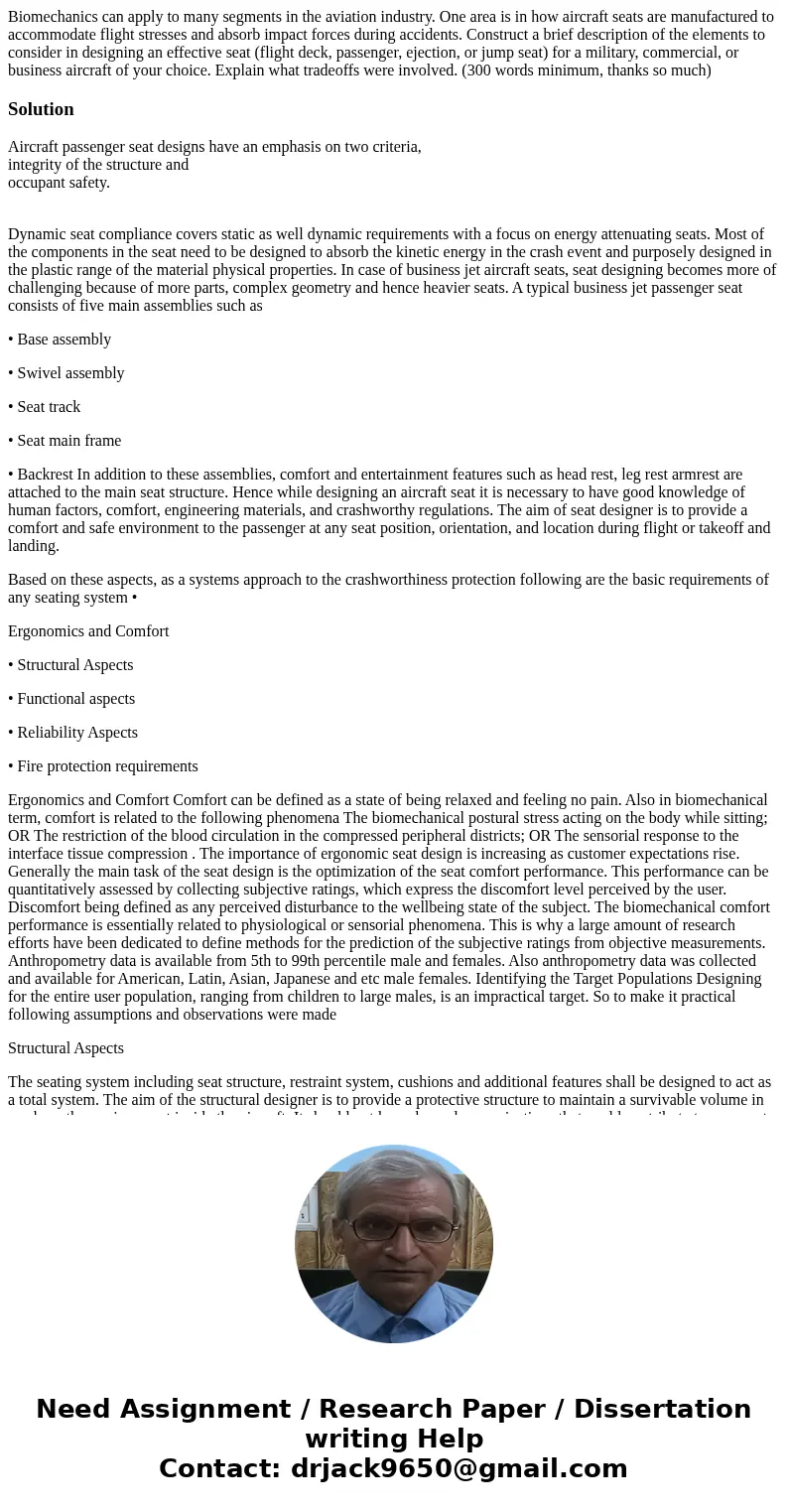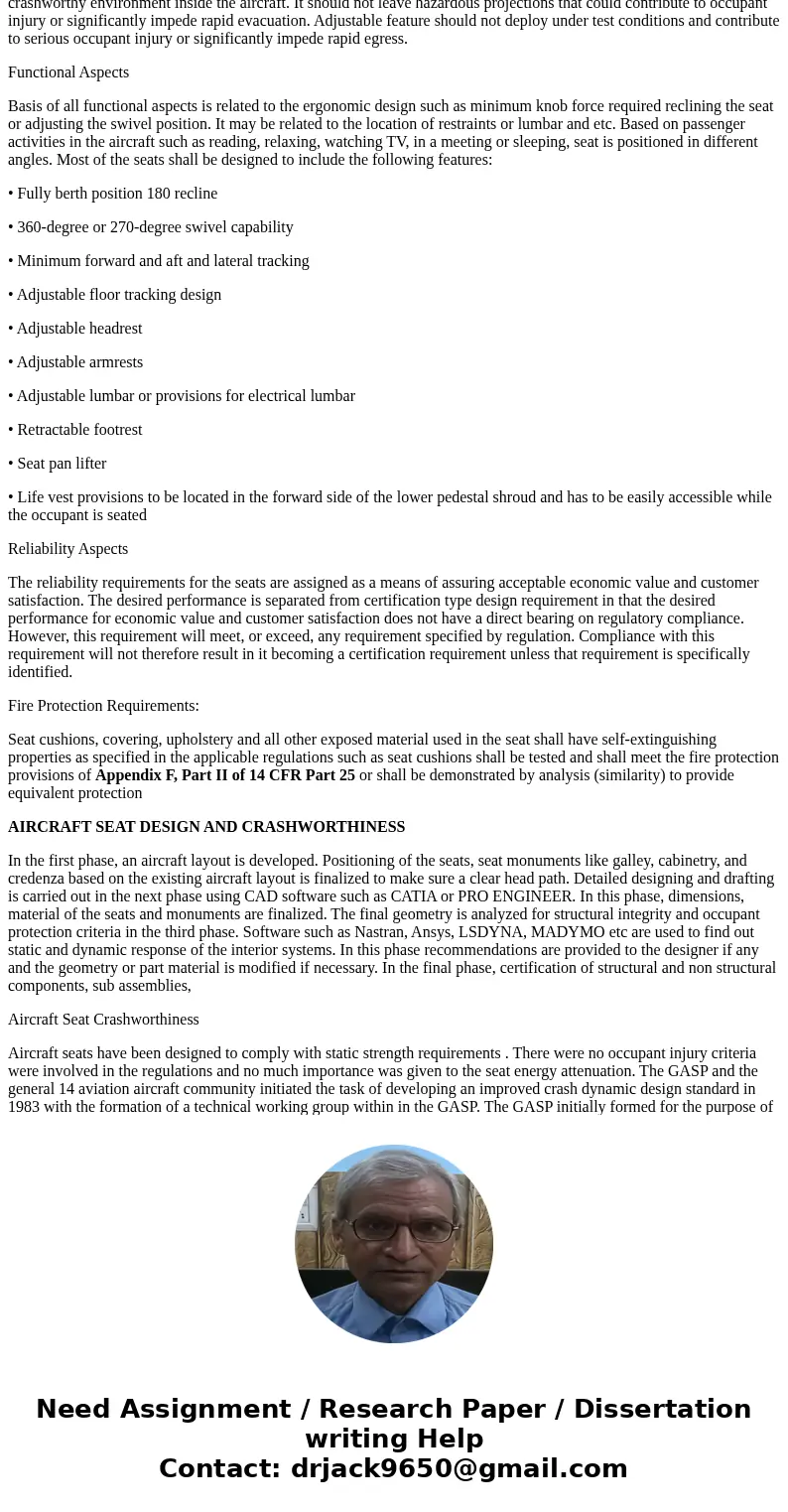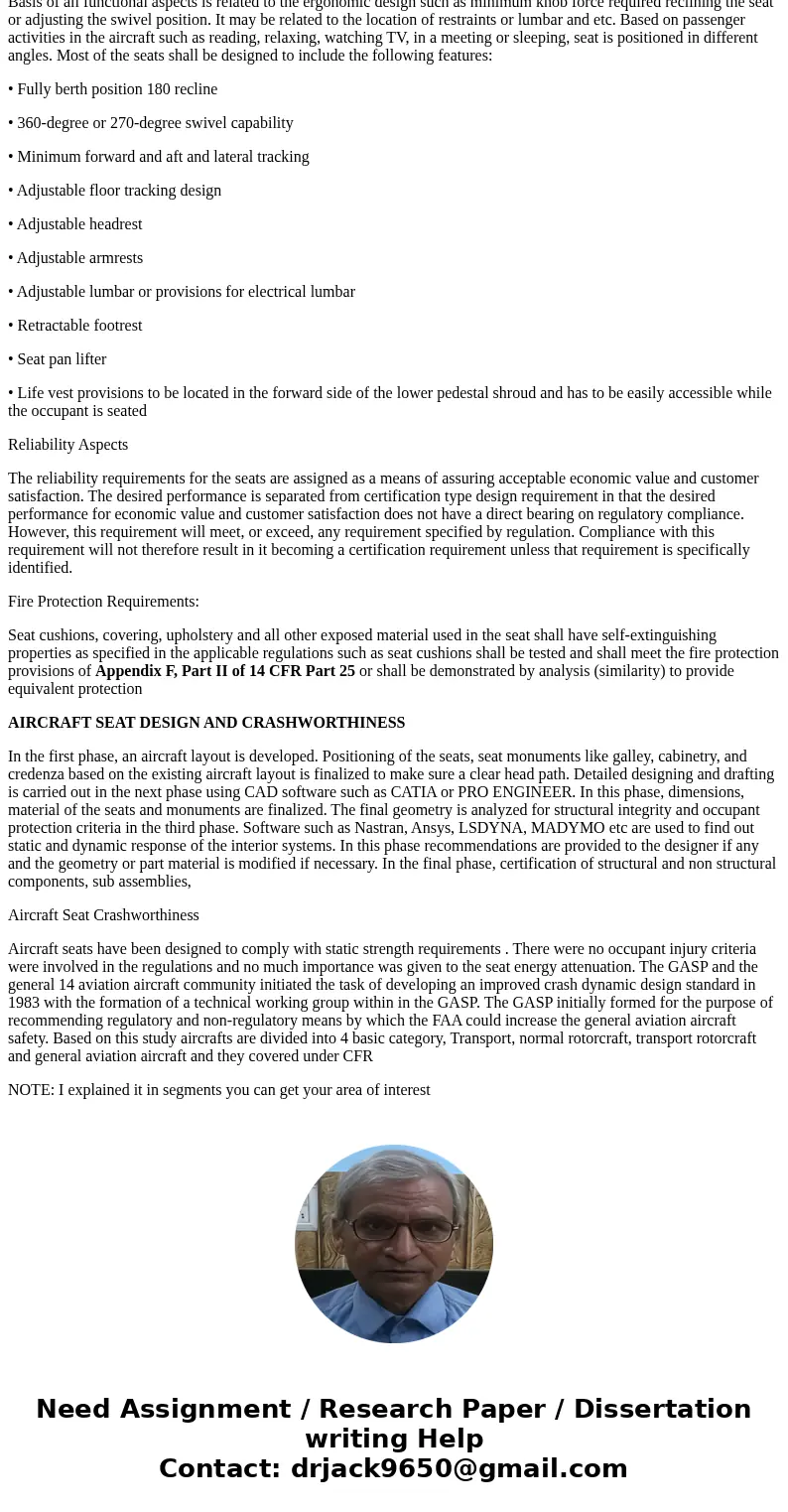Biomechanics can apply to many segments in the aviation indu
Biomechanics can apply to many segments in the aviation industry. One area is in how aircraft seats are manufactured to accommodate flight stresses and absorb impact forces during accidents. Construct a brief description of the elements to consider in designing an effective seat (flight deck, passenger, ejection, or jump seat) for a military, commercial, or business aircraft of your choice. Explain what tradeoffs were involved. (300 words minimum, thanks so much)
Solution
Aircraft passenger seat designs have an emphasis on two criteria,
integrity of the structure and
occupant safety.
Dynamic seat compliance covers static as well dynamic requirements with a focus on energy attenuating seats. Most of the components in the seat need to be designed to absorb the kinetic energy in the crash event and purposely designed in the plastic range of the material physical properties. In case of business jet aircraft seats, seat designing becomes more of challenging because of more parts, complex geometry and hence heavier seats. A typical business jet passenger seat consists of five main assemblies such as
• Base assembly
• Swivel assembly
• Seat track
• Seat main frame
• Backrest In addition to these assemblies, comfort and entertainment features such as head rest, leg rest armrest are attached to the main seat structure. Hence while designing an aircraft seat it is necessary to have good knowledge of human factors, comfort, engineering materials, and crashworthy regulations. The aim of seat designer is to provide a comfort and safe environment to the passenger at any seat position, orientation, and location during flight or takeoff and landing.
Based on these aspects, as a systems approach to the crashworthiness protection following are the basic requirements of any seating system •
Ergonomics and Comfort
• Structural Aspects
• Functional aspects
• Reliability Aspects
• Fire protection requirements
Ergonomics and Comfort Comfort can be defined as a state of being relaxed and feeling no pain. Also in biomechanical term, comfort is related to the following phenomena The biomechanical postural stress acting on the body while sitting; OR The restriction of the blood circulation in the compressed peripheral districts; OR The sensorial response to the interface tissue compression . The importance of ergonomic seat design is increasing as customer expectations rise. Generally the main task of the seat design is the optimization of the seat comfort performance. This performance can be quantitatively assessed by collecting subjective ratings, which express the discomfort level perceived by the user. Discomfort being defined as any perceived disturbance to the wellbeing state of the subject. The biomechanical comfort performance is essentially related to physiological or sensorial phenomena. This is why a large amount of research efforts have been dedicated to define methods for the prediction of the subjective ratings from objective measurements. Anthropometry data is available from 5th to 99th percentile male and females. Also anthropometry data was collected and available for American, Latin, Asian, Japanese and etc male females. Identifying the Target Populations Designing for the entire user population, ranging from children to large males, is an impractical target. So to make it practical following assumptions and observations were made
Structural Aspects
The seating system including seat structure, restraint system, cushions and additional features shall be designed to act as a total system. The aim of the structural designer is to provide a protective structure to maintain a survivable volume in crashworthy environment inside the aircraft. It should not leave hazardous projections that could contribute to occupant injury or significantly impede rapid evacuation. Adjustable feature should not deploy under test conditions and contribute to serious occupant injury or significantly impede rapid egress.
Functional Aspects
Basis of all functional aspects is related to the ergonomic design such as minimum knob force required reclining the seat or adjusting the swivel position. It may be related to the location of restraints or lumbar and etc. Based on passenger activities in the aircraft such as reading, relaxing, watching TV, in a meeting or sleeping, seat is positioned in different angles. Most of the seats shall be designed to include the following features:
• Fully berth position 180 recline
• 360-degree or 270-degree swivel capability
• Minimum forward and aft and lateral tracking
• Adjustable floor tracking design
• Adjustable headrest
• Adjustable armrests
• Adjustable lumbar or provisions for electrical lumbar
• Retractable footrest
• Seat pan lifter
• Life vest provisions to be located in the forward side of the lower pedestal shroud and has to be easily accessible while the occupant is seated
Reliability Aspects
The reliability requirements for the seats are assigned as a means of assuring acceptable economic value and customer satisfaction. The desired performance is separated from certification type design requirement in that the desired performance for economic value and customer satisfaction does not have a direct bearing on regulatory compliance. However, this requirement will meet, or exceed, any requirement specified by regulation. Compliance with this requirement will not therefore result in it becoming a certification requirement unless that requirement is specifically identified.
Fire Protection Requirements:
Seat cushions, covering, upholstery and all other exposed material used in the seat shall have self-extinguishing properties as specified in the applicable regulations such as seat cushions shall be tested and shall meet the fire protection provisions of Appendix F, Part II of 14 CFR Part 25 or shall be demonstrated by analysis (similarity) to provide equivalent protection
AIRCRAFT SEAT DESIGN AND CRASHWORTHINESS
In the first phase, an aircraft layout is developed. Positioning of the seats, seat monuments like galley, cabinetry, and credenza based on the existing aircraft layout is finalized to make sure a clear head path. Detailed designing and drafting is carried out in the next phase using CAD software such as CATIA or PRO ENGINEER. In this phase, dimensions, material of the seats and monuments are finalized. The final geometry is analyzed for structural integrity and occupant protection criteria in the third phase. Software such as Nastran, Ansys, LSDYNA, MADYMO etc are used to find out static and dynamic response of the interior systems. In this phase recommendations are provided to the designer if any and the geometry or part material is modified if necessary. In the final phase, certification of structural and non structural components, sub assemblies,
Aircraft Seat Crashworthiness
Aircraft seats have been designed to comply with static strength requirements . There were no occupant injury criteria were involved in the regulations and no much importance was given to the seat energy attenuation. The GASP and the general 14 aviation aircraft community initiated the task of developing an improved crash dynamic design standard in 1983 with the formation of a technical working group within in the GASP. The GASP initially formed for the purpose of recommending regulatory and non-regulatory means by which the FAA could increase the general aviation aircraft safety. Based on this study aircrafts are divided into 4 basic category, Transport, normal rotorcraft, transport rotorcraft and general aviation aircraft and they covered under CFR
NOTE: I explained it in segments you can get your area of interest



 Homework Sourse
Homework Sourse